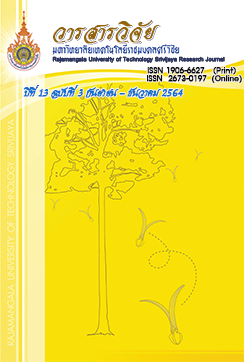ผลการทดแทนบ๊วยสดด้วยบ๊วยดองเค็มต่อคุณภาพผลิตภัณฑ์อุเมะชู
คำสำคัญ:
อุเมะชู, บ๊วย, เหล้าบ๊วย, บ๊วยดองบทคัดย่อ
งานวิจัยนี้ศึกษาการใช้บ๊วยดองเค็มทดแทนบ๊วยสดในการทำผลิตภัณฑ์อุเมะชู โดยการนำบ๊วยดองเค็มแช่ในน้ำสะอาดก่อนนำไปใช้เป็นระยะเวลา 24 และ 48 ชั่วโมง จากนั้นนำไปผลิตอุเมะชูโดยใช้อัตราส่วนบ๊วยสดต่อบ๊วยดองเค็มที่ 100:0, 75:25, 50:50, 25:75 และ 0:100 (w/w) ผสมบ๊วยกับแอลกอฮอล์ 40 เปอร์เซ็นต์ บ่มเป็นเวลา 180 วัน ตรวจสอบคุณสมบัติทางกายภาพและเคมีของผลิตภัณฑ์อุเมะชูในระหว่างการบ่ม พบว่า เมื่อระยะเวลาการบ่มนานขึ้นปริมาณของแข็งทั้งหมดที่ละลายได้มีแนวโน้มเพิ่มขึ้น ปริมาณกรดทั้งหมดสูงขึ้น ในขณะเดียวกันค่าความเป็นกรด-ด่างลดลง และค่าความสว่าง L* ค่าสีแดง a* และค่าสีเหลือง b* มีแนวโน้มเพิ่มขึ้น เมื่อเปรียบเทียบกับการบ่มเป็นเวลา 0 วัน และจากการทดสอบทางประสาทสัมผัสโดยวิธี 9-point hedonic scale พบว่าสูตรของอุเมะชูจากบ๊วยสดต่อบ๊วยดองเค็ม ที่อัตราส่วน 75:25 และ 50:50 มีคะแนนความชอบในด้านกลิ่น รสชาติ ความใส และความชอบโดยรวมสูงสุด ซึ่งมีค่าคะแนนไม่แตกต่างกัน (p > 0.05) แต่ผลิตภัณฑ์อุเมะชูที่ผลิตจากบ๊วยดองเค็มที่ผ่านการแช่ในน้ำก่อนเป็นระยะเวลา 48 ชั่วโมง มีค่าคะแนนความชอบในด้านสี กลิ่น รสชาติ ความใส และความชอบโดยรวม สูงกว่าการแช่น้ำเป็นเวลา 24 ชั่วโมง
เอกสารอ้างอิง
AOAC. 2000. Official Methods of Analysis. 17th Ed. The Association of Official Analytical Chemists, Gaithersburg, MD, USA.
Chaikulsareewath, A. and Singhapol, S. 2016. Wine production from pineapple mixed with carrot. Agricultural Science Journal 47(2)(Suppl.): 165-169. (in Thai)
Chaikulsareewath, A. and Wongprayoon, P. 2005. Research and development of mango wine. Journal of Food Technology, Siam University 2(1): 28-35. (in Thai)
Christensen, M. 2016. A Systematic Review of Ume Health Benefits. Master of Arts in Holistic Health Studies Research Papers, The St. Catherine University. Minnesota.
Fang, J., Twito, T., Zhang, Z. and Chao, C.T. 2006. Genetic relationships among fruiting-mei (Prunus mume Sieb et Zucc.) cultivars evaluated with AFLP and SNP markers. Genome 49(10): 125-1264.
Hankitichai, K. 1999. The study on alcohol content in Garcinia atroviridis wine. Bachelor of Science Special Problem, King Mongkut's Institute of Technology Ladkrabang. (in Thai)
Kono, R., Okuno, Y., Inada, K., Tokuda, A., Hashizume, H., Yoshida, M., Nakamura, M. and Utsunomuya, H. 2011. A Prunus mume extract stimulated the proliferation and differentiation of osteoblastic MC3T3-E1 cells. Bioscience Biotechnology Biochemistry 75: 1907-1911.
Mitani, T., Horinishi, A., Kishida, K., Kawabata, T., Yano, F., Mimura, H., Inaba, N., Yamanishi, H., Oe, T., Negoro, K., Mori, H., Miyake, Y., Hosoda, A., Tanaka, Y., Mori, M. and Ozaki, Y. 2013. Phenolics profile of mume, Japanese apricot (Prunus mume Sieb. et Zucc.) fruit. Bioscience Biotechnology Biochemistry 77(8): 1623-1627.
Ogunjobi, M.A.K. and Oguwolu, S.O. 2010. Development and physicochemical evaluation of wine produced from cashew apple powder. Journal of Food Technology 8(1): 18-23.
Rerkrattanawarapohn, P. 1988. Wine from Orange. Bachelor of Science Special Problem, King Mongkut's Institute of Technology Ladkrabang. (in Thai)
Srisukong, A., Onvimol, N. and Hanphakpoom, S. 2006. The producing of beet root wine. SDU Research Journal Humanities and Social Science 2(3): 23-33. (in Thai)
Surayot, U. 2010. Processing of Fermented Germinated Purple Rice Wort. Master of Science Thesis, Chiang Mai University. (in Thai)
Thadsranoi, P., Thanomklang, P. and Pitak, U. 1999. Production of Passion Wine. Bachelor of Science Special Problem, King Mongkut's Institute of Technology Ladkrabang. (in Thai)
Topp, B.L., Noller, J. and Russell, D.M. 2007. A Report for the Rural Industries Development of Prunus mume, a New Tree Crop for Australia. Research and Development Corporation, Australia.
Utsunomiya, H., Takekoshi, S., Gato, N., Utatsu, H., Motley, D.E., Eguchi, K., Fitzgerald, G.T., Mifune, M., Frank, D.G. and Eguchi, S. 2002. Fruit-juice concentrate of Asian plum inhibits growth signals of vascular smooth muscle cells induced by angiotensin II. Life Sciences 72(6): 659-667.
ดาวน์โหลด
เผยแพร่แล้ว
รูปแบบการอ้างอิง
ฉบับ
ประเภทบทความ
สัญญาอนุญาต
เนื้อหาและข้อมูลในบทความที่ลงตีพิมพ์ในวารสารวิจัยมหาวิทยาลัยเทคโนโลยีราชมงคลศรีวิชัย ถือเป็นข้อคิดเห็นและความรับผิดชอบของผู้เขียนบทความโดยตรง ซึ่งกองบรรณาธิการวารสารไม่จำเป็น ต้องเห็นด้วย หรือร่วมรับผิดชอบใดๆ
บทความ ข้อมูล เนื้อหา รูปภาพฯลฯ ที่ได้รับการตีพิมพ์ในวารสารวิจัย มหาวิทยาลัยเทคโนโลยีราชมงคลศรีวิชัย ถือเป็นลิขสิทธ์ของวารสารวิจัย มหาวิทยาลัยเทคโนโลยีราชมงคลศรีวิชัย หากบุคคลหรือหน่วยงานใดต้องการนำทั้งหมดหรือส่วนหนึ่งส่วนใดไปเผยแพร่ต่อหรือเพื่อการกระทำการใดๆจะต้องได้รับอนุญาตเป็นลายลักษ์อักษรจากวารสาร มหาวิทยาลัยเทคโนโลยีราชมงคลศรีวิชัยก่อนเท่านั้น







